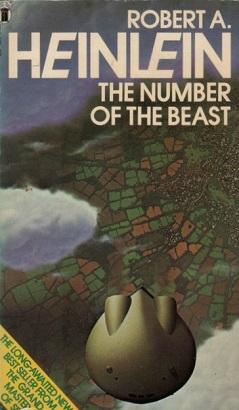The Number of the Beast (novel) facts for kids

First edition (UK)
|
|
| Author | Robert A. Heinlein |
|---|---|
| Cover artist | Tim White |
| Country | United States |
| Language | English |
| Genre | Science fiction |
| Publisher | New English Library (UK) Fawcett (US) |
|
Publication date
|
Jan 1980 (UK) |
| Media type | Print (Paperback) |
| ISBN | 0-449-13070-3 |
| OCLC | 21020774 |
| Followed by | The Cat Who Walks Through Walls |
The Number of the Beast is an exciting science fiction novel written by American author Robert A. Heinlein. It was first published in 1980. Parts of the story were also shared in Omni magazine before the book came out.
Contents
Exploring the Story: The Number of the Beast Plot
The book tells its story through diary entries. These entries are mostly written by the four main characters. They are Zebadiah "Zeb" John Carter, and his wife Dejah Thoris "Deety" Burroughs Carter. Also writing are Deety's father, Professor Jacob Burroughs, and their friend Hilda Corners. The names "Dejah Thoris," "Burroughs," and "Carter" are nods to characters from the "Barsoom" novels by Edgar Rice Burroughs.
The Start of the Adventure
The story begins at a party at Hilda's house. Deety is dancing with Zeb. She wants Zeb to meet her dad. She thinks Zeb wrote an article about different dimensions. Zeb explains he is not the author, but a relative with a similar name.
After a very close dance, Zeb jokingly suggests they should get married. To his surprise, Deety agrees! Zeb is shocked but then accepts. As they leave, they help Jacob. He is having a big argument with another professor. Hilda decides to join them. Zeb suddenly feels something is wrong. He pulls everyone behind another car. Just then, Jacob and Deety's car explodes!
Zeb quickly gets everyone into his special flying car. It's called the Gay Deceiver. He activates its flying mode. They escape without being seen by the police or the criminals.
A Double Wedding and a Hidden Cabin
Zeb flies them to Elko, Nevada. This state allows people to get married quickly. Jacob is so shaken by the explosion that he agrees to marry Hilda. So, they have a double wedding ceremony. After that, the two couples go to Jacob's secret cabin in the woods. They spend their honeymoons there.
Traveling Through Universes
This is how their adventures begin. The four friends travel in the Gay Deceiver. This car has Professor Burroughs's "continua device." It also has weapons from the Australian Defence Force. Professor Burroughs built the continua device. He was working on his ideas about different dimensions.
The universe in the book has six dimensions. Three are the space dimensions we know. The other three are time dimensions. The continua device can travel through all six. This means it can go to different fictional universes. They visit places like the Land of Oz. They can also travel through time.
They try to visit Barsoom (from the Edgar Rice Burroughs books). They end up on a version of Mars that seems to be ruled by the British and Russian Empires. Later, a character named Lazarus Long suggests it was Barsoom. He hints that the "colonial" look was an illusion. The people of Barsoom are very good at telepathy. They made the travelers see what they expected.
The Number of the Beast: What Does the Title Mean?
In the novel, the biblical number of the beast is not 666. Instead, it is a much larger number. It is  , which equals 10,314,424,798,490,535,546,171,949,056. This huge number represents the first number of parallel universes. These universes can be reached using the continua device.
, which equals 10,314,424,798,490,535,546,171,949,056. This huge number represents the first number of parallel universes. These universes can be reached using the continua device.
Later, Jacob thinks that this number might just be the universes you can reach instantly from one spot. He believes there are actually an infinite number of universes.
Writing Style: How the Book is Written
The Number of the Beast is a mix of parody and homage. It playfully copies the style of old pulp novels from the 1930s. Many parts of the story and characters come directly from these old adventure stories. The very first line of the novel shows this:
He's a Mad Scientist and I'm his Beautiful Daughter.
Hidden Jokes and Meanings
The book also has many in-jokes and references to the author. For example, the name of every bad guy is an anagram. This means it's a rearranged version of a name or pen name of Robert or Virginia Heinlein.
Like in many of his later books, Heinlein talks about the idea of solipsism. This is the idea that only your own mind is real. In this book, he expands it into something called "World as Myth." This idea suggests that universes are created when you imagine them. So, all fictional worlds are real. And all real worlds might just be imagined by fictional characters. This is why Heinlein uses the Ouroboros symbol in later books. It also connects to the idea of "Thou Art God" from his earlier book Stranger in a Strange Land.

